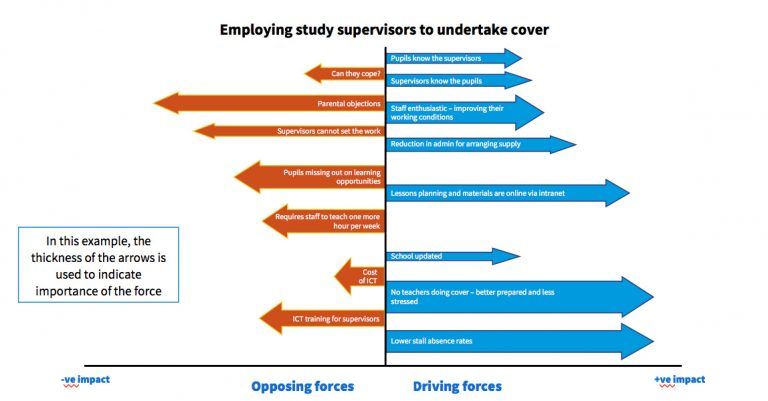Force-Field Analysis is a structured decision making technique to help you improve the chances your change project or program is successful.
The idea behind Force-Field Analysis is that when change isn't moving forwards as you would like it's because there are equally strong restraining forces holding back the driving forces.
To get your change project or program back on track you can either lessen the impact of the restraining forces or you can increase the potency of the driving forces (or both).
The process laid out below visualizes your current position and helps you and your group / team rebalance the forces in your favor so the change becomes much more likely to succeed.
Objectives
- To help your group / team manage change better.
- To help them understand the balance of the driving forces that are pushing the organization towards change and the restraining forces pushing against the change.
What Is Force-Field Analysis?
- Kurt Lewin, a pioneer in the study of change, developed the concept of force-field analysis to enable people to manage change better.
- Lewin suggests that change results from the relative strengths of competing, driving and restraining forces – the driving forces push the organization towards change; the restraining forces push against change.
- Force-field analysis helps you to understand the balance of driving forces and restraining forces in respect of a particular change.
- Based on this understanding your group can identify appropriate restraining forces to remove or decrease and identify appropriate driving forces to increase.
When Would You Use It?
- Use this early on in a project or program to identify the most effective ways to bring about change.
- The results of an analysis translate into implementation actions.
Are There Any Rules?
- Brainstorming works well to identify both driving and restraining forces – so apply usual brainstorming rules.
- Ensure that you quantify the impact of each force.
- Analysis is much more powerful when done in a group rather than individually because it forces you to achieve a level of consensus.
Resources Required
- Large piece of blank paper put up on a wall.
- Enough space around the paper that everyone in the group can easily get access.
- Marker pens and post-it notes.
Process
- Clearly state what change you are looking to bring about (or perhaps it is an option for change that you wish to explore). Write this at the top of your diagram.
- Draw a vertical line down from the statement of change. On the right of the line, you can brainstorm the driving forces; on the left of the line, you can brainstorm the restraining forces.
- For each force, agree a score between 0 and 5 to reflect the extent of the impact (positive or negative).
- Draw an arrow where the length is equivalent to the score agreed and the thickness of the arrow is used to represent the relative importance of the force.
- Brainstorm (or use a problem-solving technique like Problem Solving Team Building) to generate solutions for increasing driving forces and reducing restraining forces.
- Create an action plan using the action plan template.
Example(of a school using force-field analysis)

Action Plan Template
| Strategy (How?) | Action (What?) | Responsible (Who?) | Location (Where?) | Timing (When?) |
|---|---|---|---|---|
| | ||||
| | ||||
| | ||||
| | ||||
| | ||||
| |
Secret Sauce
- When you’re identifying forces let that step run for as long it needs to make sure you uncover as many forces as you can. It’s quantity, not quality, that’s important at that stage.
- These questions may help you uncover forces:
- What are the benefits of the change?
- What might go wrong?
- Who is set to gain? Who is set to lose out? What might their reaction be?
- Do we have sufficient resources set aside (incl. people, money, time)?
- What business processes are most likely to be affected?
- What is the general mood like in our organization towards the change? If positive, how do we keep that going? If negative, how can we turn that around?
- This is not a quick activity to complete. The complexity of the analysis is directly proportional to the complexity of the change. To avoid being overwhelmed schedule breaks and follow-on sessions when the energy levels drop.
- For the change to be successful your driving forces need to be much stronger than your restraining forces. Encourage your group towards a 2:1 ratio to allow for driving forces that turn out to be weaker and for restraining forces that are stronger than expected.

